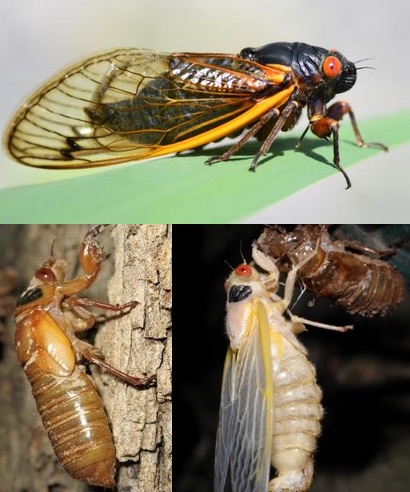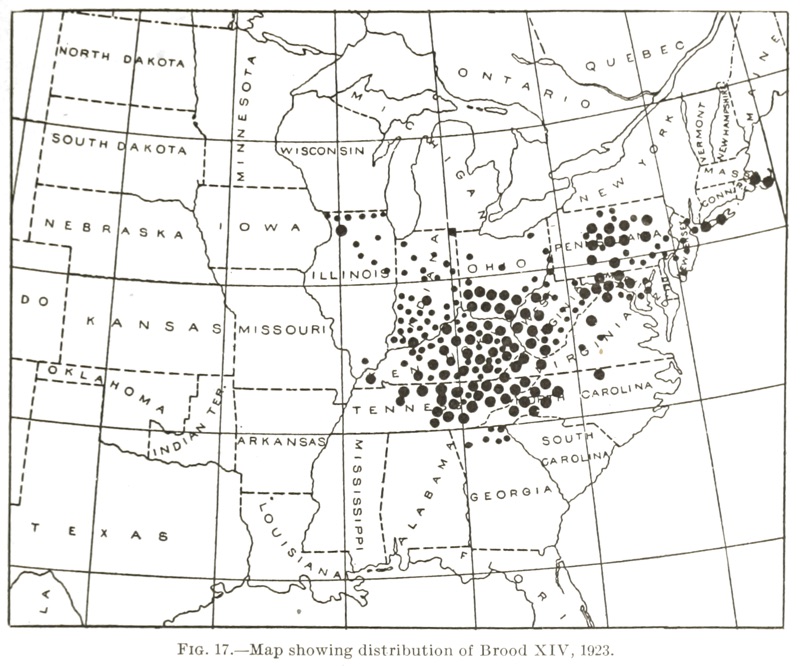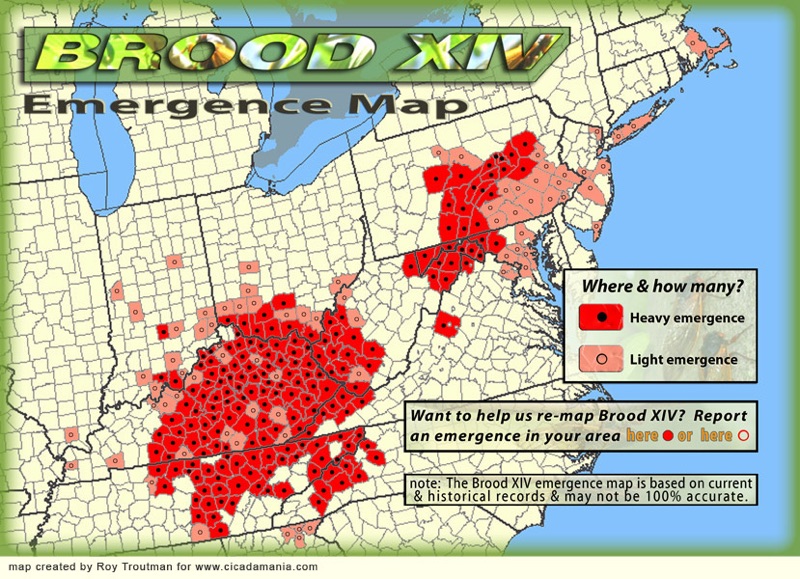Periodical cicada Brood XIV (14) will emerge in the spring of 2025 in Georgia, Kentucky, Indiana, Massachusetts, North Carolina, New Jersey, New York, Ohio, Pennsylvania, Tennessee, Virginia, West Virginia. The last time this brood emerged was in 2008. Special note: removing Maryland from the list at the request of the State Entomologist of Maryland.
What:
Millions of these Magicicada cicada insects:

- Cicadas with a 17-year life cycle.
- Some people call them “locusts” but they’re really cicadas.
- Which species: All three 17-year species, Magicicada septendecim, Magicicada cassini and Magicicada septendecula. How to tell the difference between the species.
- NOT the green ones (Neotibicen) that arrive annually.
When:
Usually beginning in May and ending in late June. These cicadas emerge approximately when the soil 8″ beneath the ground reaches approximately 64 degrees Fahrenheit. Above ground temperatures in the 70’s-80’s help warm the soil to that point. A warm rain will often trigger an emergence.
Other tips: these cicadas will emerge after the trees have grown leaves, and, according to my own observation, around the same time Iris flowers bloom.
Where:
City data comes from May 2008 and June 2008 blog comments. County locations are historical and may no-longer be accurate*.
- Georgia counties: Fannin, Lumpkin, Rabun, Union. We’re talking the northeastern part of Georgia, within the Blue Ridge Mountains region.
- Indiana counties: Crawford, Harrison, Perry. We’re talking the southern part of Indiana, by the Ohio River.
- Kentucky counties: Anderson, Barren, Bath, Bell, Bourbon, Boyd, Bracken, Campbell, Carter, Clinton, Edmonson, Fayette, Franklin, Floyd, Gallatin, Grant, Hardin, Harrison, Henderson, LaRue, Laurel, Leslie, Logan, Madison, McCreary, Montgomery, Nelson, Nicholas, Pendleton, Pike, Pulaski, Rowan, Scott, Shelby, Whitley. We’re talking most of Kentucky east of U.S. Route 41, with major hot-spots along the Ohio river.
- Kentucky cities: Adairville, Bowling Green, Corbin, Flemingsburg, Frankfort, Greensburg, Hazard, Jeffersontown (J-Town), Louisville, Radcliff, Richmond, Valley Station
- Massachusetts counties: Barnstable, Plymouth. We’re talking Cape Cod.
- Massachusetts places: (western half of) Cape Cod
- New Jersey counties: Atlantic, Camden, Ocean. We’re talking southern New Jersey, where the Jersey Devil lives (he might have ate them all up).
- New Jersey cities: Linwood, Manchester Township, Winslow Township
- New York counties: Nassau, Suffolk. We’re talking Long Island.
- New York cities: East Setauket and Dix Hills (thanks Elias Bonaros).
- North Carolina counties: Buncombe, Burke, Caldwell, Catawba, Henderson, McDowell, Mitchell, Wilkes. We’re talking western North Carolina, particularly areas heavily impacted by Hurricane Helene. It will be interesting to see if the cicadas were impacted as well, as flooding may have washed away their underground tunnels and habitat.
- North Carolina cities: Asheville, Moravian Falls, north-west of Nashville, Wilkesboro
- Ohio counties: Adams, Brown, Butler, Clermont, Clinton, Gallia, Hamilton, Highland, Ross, Warren. We’re talking south-western Ohio, with the hottest spots just east of Cincinnati. This is the homeland of cicada-experts Gene Kritsky and Roy Troutman, and world-famous botanist Matt Berger.
- Ohio cities: Batavia, Blue Ash, Cincinnati area, Indian Hill, Loveland, Maderia, Mariemont, Milford, Miami Twp.
- Pennsylvania counties: Adams, Berks, Blair, Cambria, Centre, Clearfield, Clinton, Cumberland, Huntingdon, Lackawanna, Luzerne, Lycoming, Mifflin, Montour, Northumberland, Snyder, Union. We’re talking central Pe,nnsylvania, and random locations toward the east.
- Pennsylvania cities: Bear Gap, Elverson
- Tennessee counties: Bledsoe, Blount, Campbell, Carter, Cheatham, Claiborne, Cocke, Coffee, Cumberland, Davidson, Grainger, Grundy, Hancock, Hawkins, Jefferson, Marion, Putnam, Roane, Robertson, Rutherford, Sevier, Sumner, Unicoi, Williamson. We’re talking north of Nashville, north-west of Chattanooga and in random places in the eastern half of the state.
- Tennessee cities: Cades Cove, Goodlettsville, Hampton, Muddy Pond
- Virginia counties: Botetourt, Lee, Russell, Scott, Smyth, Tazewell, Wise. We’re talking western Virginia, and mostly the part tucked under Kentucky.
- West Virginia counties: Cabell, Kanawha, Mason, Mingo, Putnam, Wyoming. We’re talking the area west of Interstate 77 (I-77), bordered by Kentucky and Ohio.
- West Virginia cities: Huntington
More Location Tips:
- Cicadas @ UCONN has the most up to date maps. Zoom in and look for the images of cicadas.
- Not sure about your town? Ask someone in your community who lived there 17 years ago.
- Try Dr. Gene Kritsky’s new book The Pilgrims’ Promise: The 2025 Emergence of the Periodical Cicada Brood XIV
- At the time of the emergence, use the Cicada Safari app or iNaturalist to see where they are emerging.
* Although county locations may no longer be accurate, I like to keep them on the page in case someone discovers a small, secret or unknown population of these cicadas. People might be disappointed, but we want to know for sure that the cicadas are (or are not) thriving in historical locations. This is the cicada researcher’s dilemma: either focus on the guaranteed/sure shot locations for the general public to enjoy, or include the obscure, relic locations so we do not miss out on rare cicada sightings. Cicadas @ UCONN talks about the relationship between the different broods — Brood XIV and Brood X are closely related geographically and genetically. You might find a Brood X straggler emerging 4 years late, and mistake it for Brood XIV. If a large number (large enough to sustain future emergences) of Brood X makes the 4-year “JUMP” to be in synch with Brood XIV, they technically become Brood XIV (and the reverse is true).
1907 Map
This map comes from the 1907 publication Marlatt, C.L. 1907. The periodical cicada. Washington, D.C.: U.S. Dept. of Agriculture, Bureau of Entomology.

A more modern map made by Roy Troutman

More facts and fun:
- Use the correct image and the correct language when talking about these cicadas. Here’s some images you can share.
- Use the Periodical Cicada Emergence Checklist for the Maximum Magicicada Experience.
- All cicada questions that are frequently asked.
- The 17 Most Interesting Periodical cicada facts.
- Cicada Mania Crossword Puzzle. It isn’t easy.
35 replies on “Brood XIV (14) Cicadas will emerge in 2025 in twelve states”
Can you tell me how much of a presence any of the cicadas will have in the Rockville, Maryland area? According to all the info I can find, it looks very light to non-existent.
Rockville has Brood X instead of Brood XIV. Brood X emerged in 2021. You might see some “stragglers” from Brood X that emerge 4 years late (which is common with Magicicada).
Hello,
I am an educator in Maryland, and noticed that you have removed Maryland from the list of states that will see Brood XIV. Can you tell me why you have changed this? I partner with Conservation Nation, and am guiding my students through their “I am a Friend to Cicadas” booklet in anticipation of their arrival.
I would like to be able to share with my students why they will not be emerging this year.
@Melissa, Gaye Williams, State Entomologist of Maryland requested that I remove Maryland.
I double checked with John Cooley of the University of Connecticut, and he agreed. To paraphrase, the cicadas found in the “narrow waist” of Maryland were likely Brood X stragglers, and not Brood XIV.
From the UCONN Map:
Now, there is a chance the cicadas in the “waist” are actually Brood XIV, and not Brood X stragglers. I encourage folks in Maryland to look for them this year, but do not be disappointed when they do not find any.
Hi Dan, I recently checked with Gene Kritsky and John Cooley about the appearance of Brood XIV in Maryland. Gene sent me a pretty long list of historical sightings associated with Brood XIV in Maryland and John mentioned a sighting in 2008 in Maryland but said it was a small one, possibly stragglers from Brood X or another brood. I will be spending some time in Washington County to see if these guys show up. Very exciting.
Interesting. The state entomologist of Maryland asked me to remove Maryland from the list, and John Cooley is in agreement. I’ll reach out to Gene.
Is cicada emergence something you can go and see–i.e., if I follow along with time and place reports, can I go to a nature reserve and expect to see them emerging all over? I live in the Boston area and don’t have a car of my own, but I’d like to make a day trip to see them in Massachusetts if possible, and I’m not sure if that’s a realistic idea. I’m sure there is a lot of unpredictability and I don’t know if the volume is enough to be such a concentrated event.
Does anyone know if Brood XIV will be in Nantucket?
Possibly, but looking at the UConn map, which has data from the last emergence, they’re limited to Cape Cod.
I’ve checked a lot of maps, and they don’t agree as to where Brood XIV will appear. Your prediction for the Martinsburg WV to Front Royal VA corridor? Thanks.
Maybe. Take a look at the map on the UConn site.
Looks like Brood X are in those locations, with some Brood XIV around but not in the same area (orange dots on the UConn map). It looks like that area is Brood X, not XIV. We’ll have to see. If you find any, we need your help — use the iNaturalist app to add your sighting.
hi dan, gaye here. please visit: cicadas.info to see the accurate midatlantic brood maps. this info has been carefully,locally investigated over many years. Maryland hosts only: Brood V in far western Md, II in a small area of southern Md, X in most of central Md, and XIX in a tiny ‘relic’ population of far southern Md. you will also note that in the midatlantic, Brood XIV [lilac on map] is in sw-West Va, sw-Va and e-central
Pa. .
Thanks Gaye. I touched base with John Cooley because the UConn map lists them. He is going to update their site as well. The 1991 and 1974 sightings their map lists are likely stragglers from Brood X.
How many calories does a cacada have? Black Bears have been documented eating them. Thank you!
Gerald D. Hodge, Jr.
Lieutenant Colonel, U.S. Army (Retired)
Founder & CEO, Appalachia Georgia Friends of the Bears, Inc.
I’m not sure about cicadas, but I just read that, according to gundersenhealth.org, “one-hundred grams of crickets contains about 120 calories and 8-25 grams of protein, while 100 grams of sirloin steak contains about 200 calories and 19-26 grams of protein.” Although crickets and cicadas are not closely related, they’re made of the same types of fats, proteins and chitin. A periodical cicada weights about 1.2 grams… so about 80 cicadas= 120 calories. So if a bear needs 2,400 calories a day, it would have to consume 1,600 cicadas.
Hi all! I’m excited for the cicadas’ return in NJ. Although I’m in North Jersey (Bergen County), my childhood streets were once filled with cicadas in full bloom. I’ve been eagerly awaiting their return but haven’t come across any yet during their emergence. I downloaded the Cicada Safari app and hope others have too! I’m willing to travel to find areas where my childhood cicada friends are thriving.”
This time it will be more of a treasure hunt than a festival. Brood XIV is (hopefully not was) is in the south, mostly in random places in the Pine Barrens. I’ll have a fun time looking for them. A common annual species Neocicada hieroglyphica aka Hieroglyphic Cicada will be out in the Pines, so that will be a “consolation prize” in case the Magicicada don’t show up. If they don’t show, I’ll blame it on the Jersey Devil.
Hey Dan I’m in Tinton falls area of NJ. I see the records and your page has them in Manchester, Winslow, and Linwood. I believe that was 1988 right? I wonder if there would still be a location here in NJ this year that they would exist.
I think it’s worth checking out, since I live in Jersey. I went to Ohio last time around, and that was excellent. But, I’ve always overlooked New Jersey for Brood XIV, so it’s time to search them out. The sightings come from Chris Simon’s data, which is I think is from 1991.
Linwood, NJ Location
Near the river where Bartlett Ave meets W Monroe Ave. Near Rt. 9.
https://maps.app.goo.gl/wVbpU3h4rJjUktqt6
Winslow Township, NJ Location
Near the intersection of Berlin Cross Keys Rd and Sharp Ave.
https://maps.app.goo.gl/YwcdKNSZcP1LBZme7
Manchester Township Location
In the woods between Beckerville Road and Rt. 70. Near a gun club (don’t get shot).
https://maps.app.goo.gl/peSmoc3uo5sTQL4p9
Neocicada hieroglyphica aka Hieroglyphic Cicada could be out in the Pine Barrens in early June, so a trip to look for Magicicada could also feature Hieroglyphics.
We are having some super cold days this winter. Is there a correlation between the winter temperatures and the time of the cicada emergence? I have heard that a cold winter affects insect hatching in the spring.
As long as things warm up in the spring we should be fine.
The soil has to reach 64 in temperature. Leave on the trees. I would say mid May.
Thank you
for information Fahrenheit
Are they coming to NE Ohio (Cuyahoga and summit counties) in 2025?
Geauga has a sighting back in 1988, but not Cuyahoga.
Map above
It’s bizarre to me that Louisville/Jefferson county is left out when we have a horrendous amount of cicadas emerge with brood XIV each emergence…
Putnam County in TN is on the modern map for a heavy emergence, it just got left off the text list of counties, I think.
Do you have an XML file available so I can input into QGIS?
I don’t but John Cooley of the UCONN site should.
Thank you
Thank you. Much needed information. Keep me posted…
Thank you! This is great info!